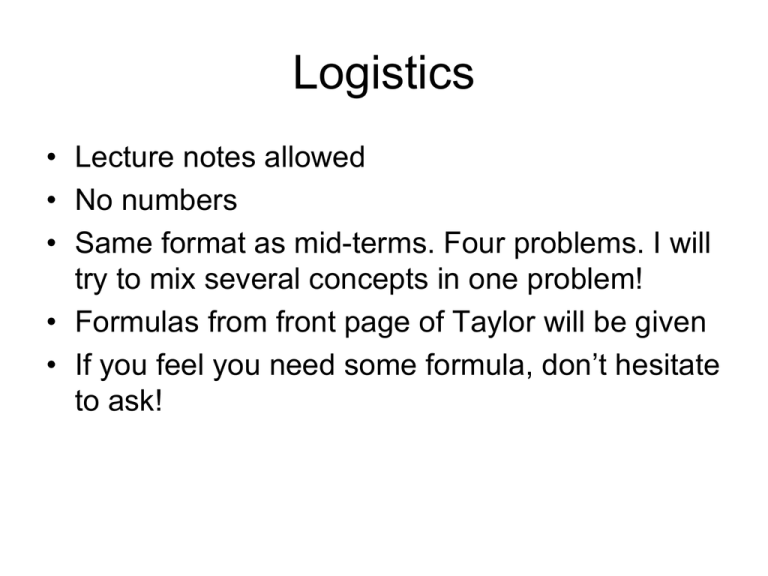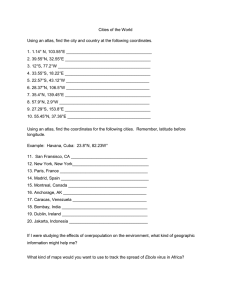Review your lecture notes and make sure they are complete Read
advertisement

Logistics • Lecture notes allowed • No numbers • Same format as mid-terms. Four problems. I will try to mix several concepts in one problem! • Formulas from front page of Taylor will be given • If you feel you need some formula, don’t hesitate to ask! How to prepare • Review your lecture notes and make sure they are complete • Read the handouts that I posted • Solve all homework • Solve your mid-term tests • Solutions are posted, but don’t look at them before you solve the problem! • Work out examples in textbook and lecture notes, and look through end-of-chapter problems • Don’t hesitate to contact me if you have any difficulties Math • Vectors, dot and cross product; Levi-Civita symbol • Calculus – Integrate by substitution of variable – Differential in standard coordinate systems • Vector calculus (formulas will be given as needed) • Differential equations: – – – – Solve by separation of variables Solve linear equations Solve harmonic oscillator equation Apply initial conditions • Approximations, expansions, linearization Linear problems • Know the solution to the harmonic oscillator problem! No dissipation, with dissipation, driven, any initial conditions • Know how to solve a general system of linear ODE with constant coefficients! Bird’s view of the classical mechanics Given a problem, now we know many ways to solve it • Newton’s 2nd law: intuitive, but has different form in different coordinates • The only conservation laws that can be applied “automatically” are energy, momentum, or angular momentum Lagrangian approach • Based on variational principle; therefore invariant with respect to transformation of coordinates (q1, …qn)->(Q1, …,Qn)* • Equations have the same form in any coordinate system! • In practice, you still start from natural coordinates and L = K-U, and then make the transformation of your choice *Note: velocities are not transformed independently, they follow the transformation of q Lagrangian approach: what kind of problems can be solved? • All linear problems without explicit time dependence in coefficients. L contains only qiqj and q˙ iq˙ j terms (quadratic). Then E-L equations contain only linear terms. – Linear in q˙ j term in the Lagrangian can be eliminated as a total derivative df/dt • T and U can be diagonalized simultaneously by transformation to normal frequencies and normal coordinates. Then the solution is straightforward. Expect such problem on the final exam. Coupled oscillations • Normal frequencies and normal modes • Normal coordinates: transformations in both directions • Inhomogeneous terms (e.g. constant force) • Typical problems: springs, pendulums Lagrangian approach: what kind of problems can be solved? • Nonlinear problem if – Only one degree of freedom and no time dependence, i.e. energy is conserved – Then equation E = T+U leads to the first-order equation for x(t) that can always be solved in quadratures • All other nonlinear problems can be solved only by reduction to a set of 1D problems Nonlinear problems • Need to have enough integrals of motion (equal to the number of degrees of freedom) • Within the Lagrangian approach, the only regular way of finding I.o.M. is through cyclic coordinates. Then the generalized momentum is conserved. • Choosing the right system of coordinates is critical! It should reflect the symmetry of the potential U(qi) • Examples: central force, EM field Nonlinear problems • Even when the problem is not solvable, there is a powerful qualitative method: phase space (q, q˙) or (q, p) • Motion is completely described by finding critical (stationary) points q, q˙ = 0 and trajectories in their vicinity • Motion in the vicinity of stationary points is described by linearized equations! Know how to linearize!! • Only four types of points on a 2D phase plane • Know how to find them and the structure of phase trajectories around them! Hamiltonian dynamics • Also based on the variational principle, same invariance with respect to coordinate transformations – Know how to go from L to H! (next slide) • Motion as a flow of “phase fluid” in phase space • Powerful theorems and methods: – Liouville’s theorem (conservation of phase volume) – Poisson’s brackets: generate evolution of any function f(p,q), may give new integrals of motion, allow you to check if the transformation is canonical Notable exceptions from H = K+U rule • Non-inertial reference frame, for example polar coordinates for a bead on a rotating wire • Charged particle in an electromagnetic field Canonical transformations • The greatest advantage! Transform both q and p. Much broader class than purely coordinate transformations • The main approach: transform to new canonical coordinates in which the solution to Hamilton’s equations is trivial • Know how to find the generating function and write the solution in old coordinates Hamilton-Jacobi theory • Most general way of finding integrals of motion: by separation of variables in HJ equation • Again, identifying the right system of coordinates is critical • Method in search of problems: first identify potentials and coordinates for which variables can be separated, then see what problems it can solve Know the procedure! • Choose the coordinates • Know the Hamiltonian in standard coordinate systems! • Separate variables • Write the solution • Apply initial conditions Rigid body rotation • Don’t forget PHYS218 stuff! – Center of mass – Angular momentum and it’s split into COM and “about COM” motion – Kinetic energy and it’s separation into KE of COM + KE of the motion relative to COM – Rotation about fixed axis z. Moment of inertia. Lz = Iz Ω. Polar coordinates. Rigid body rotation • L is not parallel to Ω. Tensor of inertia. • Diagonalization of TI. Principal moments and axes. Know how to do this! • Euler’s equations – Symmetric top • Lagrangian and Hamiltonian in terms of Euler’s angles – Symmetric top Non-separable (non-integrable) systems • Only approximate methods • Adiabatic invariants – Know how to find the actions and convert to action-angle variables – Know how to use adiabatic invariants to find the time dependence of energy, amplitude, and other physical quantities • Method of averaging (not needed for 2014) Road to chaos • • • • Nonlinearity Non-integrability Resonances Destruction of separatrices Resonances • Nonlinear resonance and nonlinear pendulum • Back to phase space • Instability and destruction of a separatrix • Bifurcations • Period-doubling bifurcation • Properties of chaos • From laminar to turbulent phase flow Bifurcation diagram of a driven pendulum θ(tn) γ Poincare section Poincare section of the phase plane of a driven pendulum http://www.physik3.gwdg.de http://www.elmer.unibas.ch/pendulum/chaos.htm wikipedia Poincare maps on y,dy/dt plane for Henon-Heiles problem C. Emanuelsson Self-similarity C. Emanuelsson KAM tori for Henon-Heiles problem C. Emanuelsson







